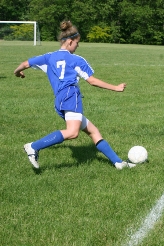Neuromuscular and educational training programs designed to prevent injuries to the anterior cruciate ligament (ACL) among young athletes appear to cut the risk of ACL injuries in half, according to a 2012 study.[1]

Performing a "meta-analysis" of data from 14 studies, researchers at the University of Michigan found that such programs appear to reduce the overall rate of ACL injuries by approximately 50%, although the estimated incidence rate ratio (IRR) varied appreciably among the studies.
Given the complexities of each training program and their differences from each other, researchers were unable to explain most of the variability, nor were they able to determine which components of the training interventions were most or least effective.
The study did find, however, that the estimated protective effect was relatively stronger in studies that were:
- not randomized;
- performed in the United States;
- involved soccer players;
- had a longer duration of follow-up (more than 1 season);
- involved more hours of training time each week; and
- in those studies where there was better compliance with the training regimen.
As a result, the study authors said new randomized trials were needed to address these issues, preferably by comparing different types of interventions, rather than comparing one intervention program with a control group undertaking no program.
Risk factors
Injuries of the anterior cruciate ligament (ACL) are considered the largest single problem in orthopedic sports medicine, with approximately 250,000 ACL injuries occuring annually in the United States.[2]
Injury to the ACL increases the risk of subsequent knee injuries and chronic knee problems, including secondary injuries and early onset osteoarthritis.
ACL injuries are the result of a combination of risk factors:
- Environmental
- playing surface
- weather
- use of footwear and/or braces
- Biomechanical
- muscle strength
- proprioception and kinesthesia (awareness of body in motion)
- lateral trunk displacement
- knee and hip flexion
- ankle stability and dorsiflection
- knee abduction/adduction
- hip/tibia rotation
- foot pronation
- hamstring flexibility
- neuromuscular control
- core strength; and
- opposing muscle ratios (e.g. hamstrings/quadriceps ratio).
- Anatomic
- Greater Q angle (the angle from the hip to the knee joint)
- pelvis width
- narrow intercondylar notch width (ratio of femoral notch width to the diameter and cross-sectional area of the ACL); and
- generalized and specific knee ligament laxity.
- Other factors:
- age
- genetic variants
- hormonal factors (e.g. preovulatory phase of menstrual cycle), and
- clinical factors (e.g. history of previous injury and body mass index [BMI]).
In soccer, the rate of ACL injury is more than twice as high in female players than in male players,[3,4] with adolescent girls especially at risk.[4,5]
Prevention strategies
A wide variety of strategies to prevent ACL injuries have been employed. Most have included two or more of the following training elements:
- neuromuscular and proprioceptive training
- stretching
- plyometrics
- movement training
- core strengthening
- balance training
- resistance training; and
- speed training.
1. Gagnier J, Morgenstern H, Chess L. Interventions Designed to Prevent Anterior Cruciate Ligament Injuries in Adolescents and Adults. A Systematic Review and Meta-Analysis. Am J Sports Med 2010. DOI: 10.1177/0363546512458227 (published online ahead of print on September 12, 2012).
2. Silvers H, Mandelbaum B. Prevention of anterior cruciate ligament injury in the female athlete. Br J Sports Med. 2007;41:i52-i59.
3. Prodromos CC, Han Y, Rogowski J, Joyce B, Shi K. A meta-analysis of the incidence of anterior cruciate ligement tears as a function of gender, sport, and a knee-injury-reduction regimen. Arthroscopy 2007;23:1320-5.
4. Walden M, Hagglund M, Werner J, Ekstrand J. The epidomiology of anterior cruciate ligament injury in football (soccer): a review of the literature from a gender-related perspective. Knee Surg Sports Traumatol Arthrosc 2011;19:3-10.
5. Shea KG, Pfeiffer R, Wang JH, Curtin M, Apel PJ. Anterior cruciate ligament injury in pediatric and adolescent soccer players; an analysis of insurance data. J Pediatr Orthop. 2004;24:623-8.
Posted September 26, 2012 Updated November 21, 2014








